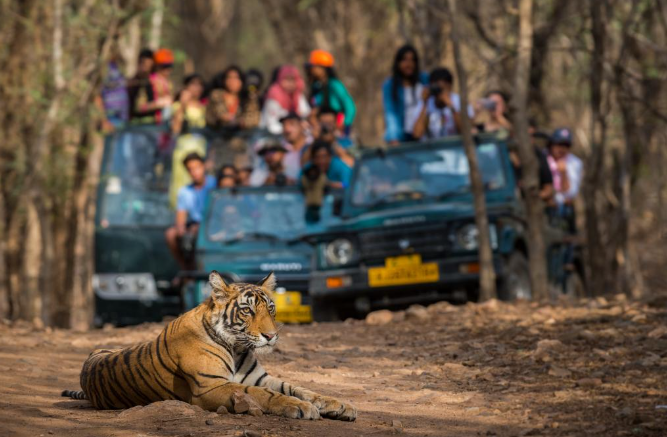India must adopt holistic approaches to handle human-wildlife conflicts (GS Paper 3, Environment & Conservation)

Context
- India, with its rich biodiversity and burgeoning human population, grapples with a significant challenge: human-animal conflict.
- As habitats shrink and human activities encroach upon wildlife territories, confrontations between humans and animals, mainly tigers and elephants, have escalated, posing threats to both communities.
- It emerges as a major taking point in states like Kerala ahead of the Lok Sabha election.
- Understanding and mitigating this conflict is crucial for fostering coexistence and preserving India's natural heritage.
Complexities underlying Human-Animal conflict
- The complexities underlying human-animal conflict in India are manifold.
- With an estimated population of around 31,000 across 29 reserves, India is home to the largest number of wild Asian elephants globally.
- Tragically, encounters with these majestic creatures result in over 500 human fatalities annually.
- Equally distressing is the fact that more than 100 elephants succumb to human-induced activities such as encroachments, mining, quarrying, ivory poaching, poisoning, encounters with electric fences, and collisions with trains.
- Similarly, India is home to more than 2,960 tigers — 75 per cent of the world’s wild tiger population.
- Human-tiger encounters due to an intricate network of factors often lead to loss of lives on both sides, especially in states like Uttar Pradesh, Assam, Bengal, Odisha, Andhra Pradesh, Telangana, Karnataka, Tamil Nadu and Kerala.
Fatalities caused by specific incidents
- In most parts, conflicts occur only at micro-local levels, with fatalities caused by specific incidents in localised areas due to human action or complex animal behaviour.
- Human safety must be prioritised per anthropocentric principles, without compromising the rights of animals or the balance of nature.
- Tigers are facing the threat of extinction, while elephants are experiencing a crisis of attrition.
Effect of Human expansion
- The relentless march of urbanisation, expansion of agricultural lands and infrastructural development significantly contribute to the fragmentation of natural habitats and animal corridors.
- As a consequence, wildlife increasingly encroaches upon human settlements.
- Moreover, the depletion of natural resources compels animals to venture into agricultural fields and villages in search of sustenance, intensifying the conflict between humans and wildlife.
- Farmers suffer crop depredation, leading to economic losses and food insecurity. Livestock predation further exacerbates these hardships.
- Additionally, human lives are at risk as encounters with large mammals, especially elephants and tigers, result in injuries and fatalities.
- Psychological distress and fear are pervasive among affected communities, perpetuating animosity towards wildlife.
Addressing the conflict
- In essence, the convergence of these factors amplifies tensions, highlighting the urgent need for comprehensive strategies to mitigate human-animal conflicts and foster harmonious coexistence between communities and wildlife in India.
- Governments in states have been attempting to address this issue using strategies such as trenches, fences, drones, radio collars, and village relocation.
- Balancing conservation efforts with human livelihood needs presents a complex dilemma. India boasts several flagship species like tigers, elephants, and leopards, emblematic of its natural heritage.
- Yet, ensuring their survival often entails restricting human activities, which can incite resentment and resistance from local communities.
- Moreover, retaliatory killings of problem animals perpetuate a cycle of violence, posing a threat to species conservation.
Multi-pronged Approach
- Addressing human-animal conflict requires a multi-pronged approach encompassing proactive measures and community involvement.
- Implementing effective land-use planning to delineate wildlife corridors and buffer zones can mitigate habitat fragmentation and reduce human-wildlife encounters.
- Employing innovative deterrent methods such as electric fencing, chilli smoke, and beehive fences can deter crop-raiding animals without harming them.
- Furthermore, investing in community-based conservation initiatives that empower local stakeholders is imperative.
- Encouraging sustainable agriculture practices, promoting livestock insurance schemes, and providing alternative livelihood options can alleviate the socio-economic burdens on communities while fostering tolerance towards wildlife.
- Education and awareness programmes aimed at fostering empathy and understanding between humans and animals are also pivotal in fostering coexistence.
Way Forward
- The Indian government has taken strides towards addressing human-animal conflict through initiatives like Project Tiger and Project Elephant, focusing on habitat conservation and mitigating conflicts involving flagship species.
- However, more concerted efforts are needed to mainstream conflict mitigation measures into policy frameworks and enhance resource allocation for on-the-ground implementation.
- Similarly, in some states, community-based volunteers or rapid response teams monitor the movements of wild animals and mitigate issues of conflict with humans.
- They are called ‘friends of wild animals’.
- Kerala, amid repeated loss of lives by animal attacks, declared human-animal conflict as a state-specific disaster, shifting the responsibility to the state disaster management authority.
Conclusion
- Human-animal conflict in India is a pressing issue that demands urgent attention and concerted action.
- By adopting holistic approaches that integrate conservation goals with community welfare, India can pave the way for sustainable coexistence between humans and wildlife.


